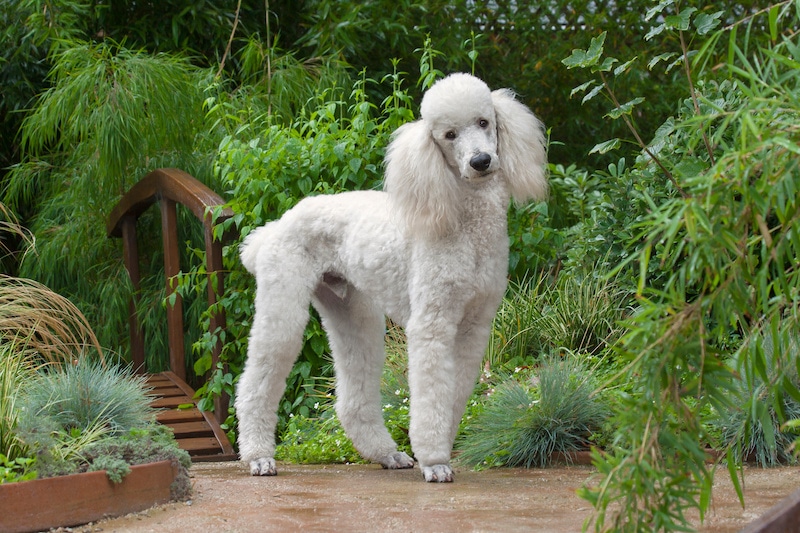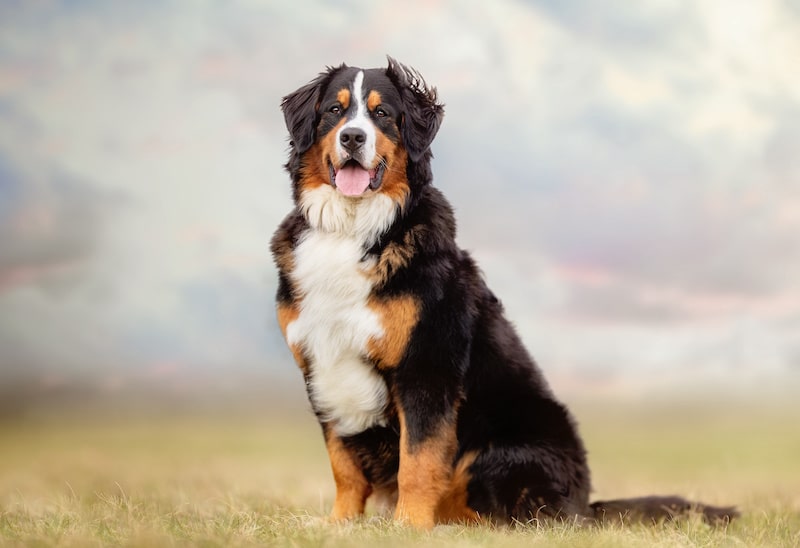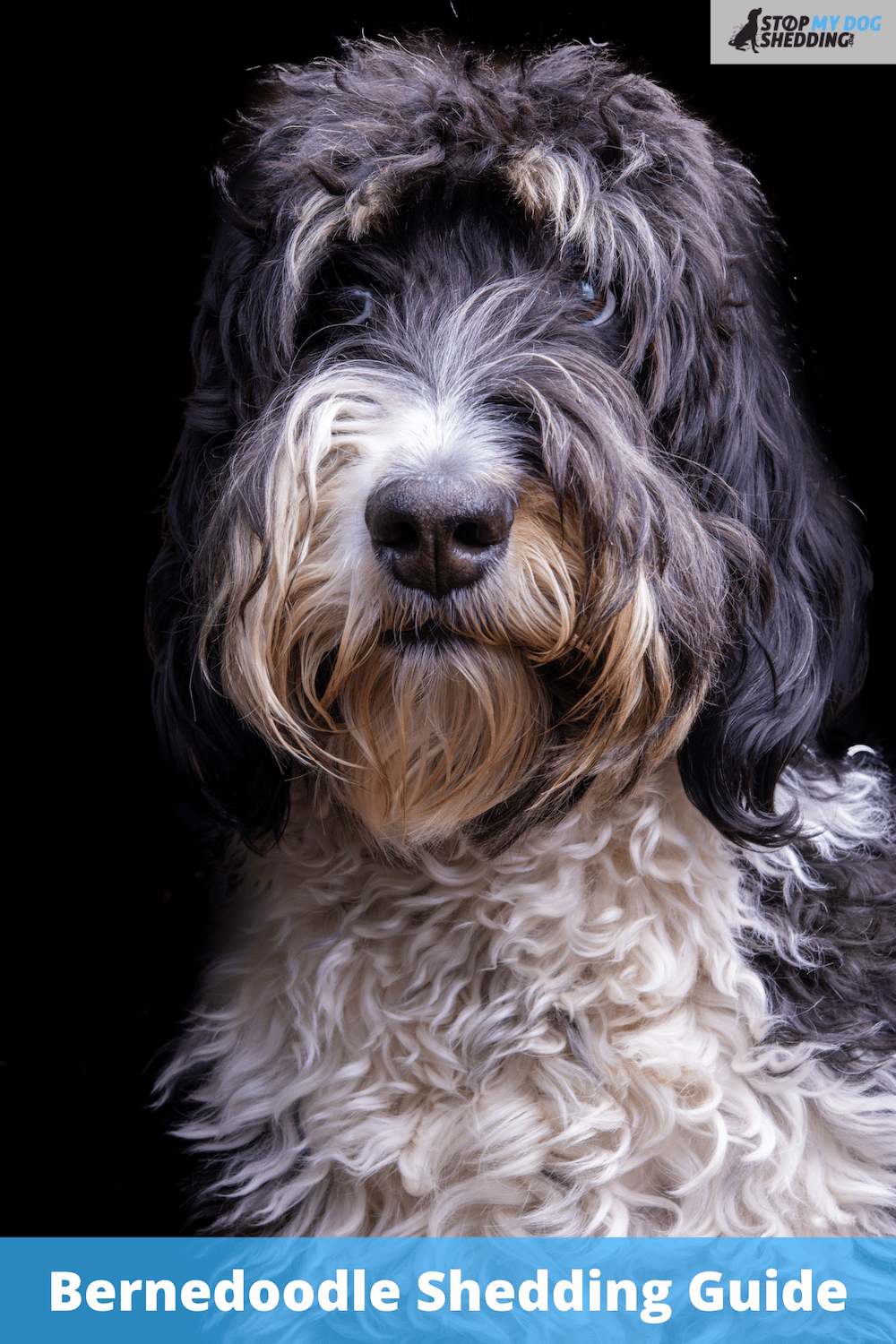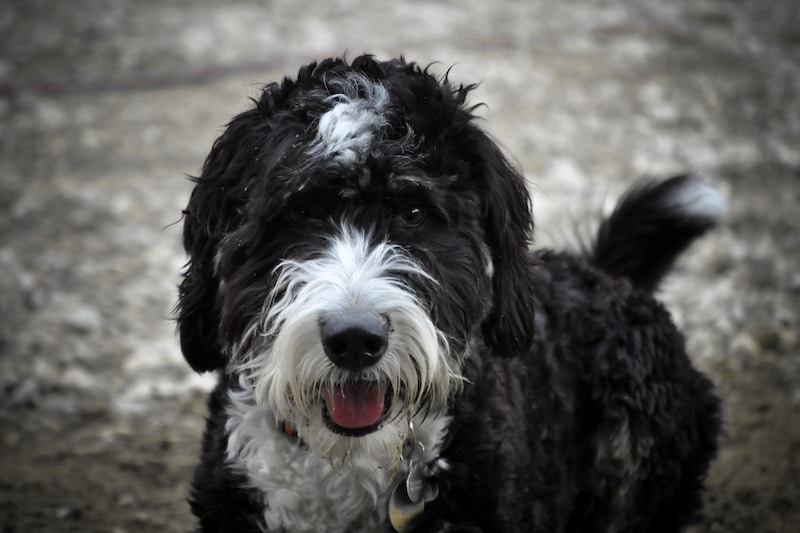The Bernedoodle (AKA Bernese Mountain Poo) is a cross between a Poodle and Bernese Mountain Dog, and it’s best known as an intelligent, affectionate companion dog.
Aside from being adorable and having a great personality, one of the reasons the Bernedoodle has become so popular is that it’s considered a low-shedding breed.
And the reason for this is that, while one of its parents (the Bernese Mountain Dog) is a very heavy shedder, its other parent (the Poodle) is one of the lowest shedders in dogdom.
That said, the amount of fur this breed drops ultimately depends on its lineage. In short, the Bernedoodle can be categorized as F1, F1B, F1BB, or F2 (among others), and the lowest shedding variety is the F1BB, as it has 87.5% Poodle and 12.5% Bernese Mountain Dog.
There are other factors that can contribute to Bernedoodle shedding, though, such as the breed’s size, coat type, and whether or not they have a double coat. But as a general rule, the more Poodle the breed has in its genes, the lower the shedding.
In this post, I’ll discuss the Bernedoodle’s shedding traits in more detail, talk about whether or not it’s (actually) hypoallergenic, and share some tips on keeping your home fur-free.
Recommended: Go here to see our top-rated dog hair blow dryers
Bernedoodle Shedding Guide: Comparing How Much the F1, F1B, and F2 Breeds Shed
The Bernedoodle is generally a low-shedding dog, but because it’s a crossbreed (AKA designer breed), how much it sheds will ultimately depend on its lineage. And as a general rule, the more Poodle your Bernedoodle is, the less hair you should see floating around the home.
This is because Bernese Mountain Dogs are, without exaggerating, one of the heaviest shedding dogs in the world. In contrast, Poodles are about as close to non-shedding as it gets, which is one of the reasons why so many dogs are crossbred with Poodles.
In any case, if you’ve spent any length of time researching Bernedoodles, or any other Poodle cross breed, you may have noticed the terms F1, F1B, F1BB, and F2 (among others) being thrown around to describe the breed.
And with all those cryptic names, figuring out what’s what can be confusing.
So, what do they mean?
And what impact does this have on shedding?
The terms F1, F1B, F1BB, and F2 are used to indicate a Bernedoodle’s generation (or lineage). They are also used to describe other types of “doodle” breeds besides the Bernedoodle like the Goldendoodle, AussieDoodle, and Labradoodle, for example.
The “F” part stands for “filial,” which essentially means “offspring.” The number represents whether the breed is a first filial generation (1) or a second filial generation (2). And the “B” part indicates that it’s a “backcross” to one of the parent breeds.
Now with that said, here are the different varieties of Bernedoodle:
- F1 Bernedoodle: The F1 is a “first filial generation” Bernedoodle, which means it’s a cross between a purebred Poodle and a purebred Bernese Mountain Dog. In other words, it’s 50% Poodle and 50% Bernese Mountain Dog. This variety is considered low shedding.
- F1B Bernedoodle: An F1 crossed with a purebred Poodle is called an F1B Bernedoodle, which ultimately results in a breed that’s 75% Poodle and 25% Bernese Mountain Dog.
- F1BB Bernedoodle: This breed consists of 87.5% Poodle and 12.5% Bernese Mountain Dog and results from crossing an F1B Bernedoodle with a purebred Poodle. And it’s the lowest shedding variety of all Bernedoodles since it’s predominately Poodle.
- F2 Bernedoodle: The F2 is what you get when you cross two F1 Bernedoodles, so it’s still half Poodle, half Bernese Mountain Dog. And this means that it typically doesn’t shed any less than an F1 because it still has the same 50/50 lineage.
There are other variants of the Bernedoodle, but those are the main ones. And there’s also a breed called the Australian Bernedoodle, but that is a completely different breed.
The Australian Bernedoodle is a cross between an Australian Labradoodle (which itself is a mix of Poodle, Labrador, Cocker Spaniel, and Irish Water Spaniel) and a Bernese Mountain Dog.
As for which one sheds more, the Australian Bernedoodle has less Poodle in it compared to the “standard” F1 Bernedoodle, so it may shed a bit more. But both are low shedders overall.
In any case, the main thing to remember is that the more Poodle-like the Bernedoodle is, the less likely it will be to shed heavily.
And if you want to know more about the different “F” and “B” generations, I recommend seeing this article on the Continental Kennel Club website, as it does a great job of breaking down the different dog generations in more detail.
There are several other key factors that can contribute to how much hair a Bernedoodle drops, too, including its coat type, size, and whether or not it’s double-coated.
So let’s discuss those now.
Recommended: Go here to see our top-rated dog hair blow dryers
Other Factors That Can Contribute to Shedding
The reality is that all dogs shed. Even the so-called “non-shedding” breeds will still drop hair from time to time. The difference is how much each breed sheds, which is largely determined by the individual breed and its hair growth cycle.
However, there are numerous other factors that can contribute to dog shedding, including the time of year, the dog’s diet, their overall health, and whether it’s a puppy or adult.
There are also several specific things to the Bernedoodle that can make a big difference in how much hair you will end up finding on your floors, furniture, and clothing. And they are its coat type, the size of the Bernedoodle, and whether it has a single or double coat.
Let’s start with the first one, coat type…
The Bernedoodle’s Coat Type (Curly, Wavy, or Straight)
The Bernedoodle typically has a curly, wavy, or straight coat (or some variety of those).
Generally speaking, adult Bernedoodles with a curly coat are most representative of the Poodle since that is one of the defining characteristics of a Poodle’s coat.

This coat can be more challenging and time-consuming to groom but will likely shed less because it means the Bernedoodle likely takes more after the low-shedding Poodle.
Also, the dead hairs are more easily trapped in a curly coat, so the hair tends to come out more during brushing instead of falling onto the floors.
On the other hand, Bernedoodles with a straight coat tend to take more after the high-shedding Bernese Mountain Dog.

So, if your Bernedoodle’s coat looks more like that of a Bernese Mountain Dog, you may notice more hair around the home. The good news is that this coat is easier to brush and maintain, which means you could end up spending a lot less time (and/or money) on grooming.
We’ve created a guide to the different dog coat types and the impact this can have on shedding, so if you want to know more, be sure to check that out.
The Bernedoodle’s Size (Tiny, Miniature, or Standard)
The size of the dog will not impact the rate at which it sheds; however, small dogs have less surface area for hair to grow. And therefore, small dogs will drop less hair than large dogs.
Regarding Bernedoodles, they come in three sizes: tiny, miniature, and standard.
This is thanks to their Poodle genes as Poodles come in toy, mini, or standard, whereas Bernese Mountain Dogs come in one size: large.
As a side note, this is another reason why some prefer adopting a Bernedoodle to a purebred Bernese Mountain Dog; Bernedoodles can be a lot smaller depending on the parents. And not only can a smaller dog drop less hair overall, but they require less effort to groom, don’t eat as much, and may get worn out faster during their daily walk.
Single v.s. Double Coated Bernedoodles
Other than having curly hair, one of the defining traits of a Poodle is that it has a single coat, which means that it only has one layer of fur.
In contrast, Bernese Mountain Dogs are double-coated. This means it has two coats: an outer layer of fur that is longer and a thick, wooly undercoat.
On the plus side, the double coat is what helps insulate the Bernese Mountain Dog in both cool and warm weather (which is one of the reasons it’s not recommended to shave it off).
On the other hand, double-coated dogs typically “blow coat” once or twice a year, which means they tend to drop more fur for several weeks at a time twice a year. And the reason for this is that they are naturally preparing for the change of season.
In the lead-up to summer, Bernese Mountain Dogs drop their thicker winter coat because it’s not needed in the warmer months. And in the lead-up to winter, they will blow coat and grow back a thicker, warmer coat.
So, don’t be surprised if your Bernedoodle sheds more heavily during spring and fall (autumn), especially if it’s an F1 Bernedoodle as these are half Bernese Mountain Dog.
Which Bernedoodle Sheds the Least?
The lowest shedding Bernedoodle is the F1BB Bernedoodle, which is 87.5% Poodle and 12.5% Bernese Mountain Dog and results from crossing an F1B Bernedoodle with a purebred Poodle.
The runner-ups are the F1B Bernedoodle (75% Poodle and 25% Bernese Mountain Dog) and the F1 Bernedoodle (50% Poodle and 50% Bernese Mountain Dog).
As I mentioned earlier, the general rule is that the lowest-shedding Bernedoodle is always the one with the highest percentage of Poodle in its genes because, unlike Bernese Mountain Dogs, Poodles are very low-shedding.
It’s possible that some Bernedoodles are even more predominately Poodle than the F1BB. But once you go beyond the F1BB, it kind of defeats the purpose of adopting a Bernedoodle in the first place because the dog would have almost no Bernese Mountain Dog in it by that point.
In terms of how much Bernedoodles shed compared to other “doodle” type dogs, the best thing to do is to compare the non-Poodle parents and how much of that breed is in the mix.
For example, the Goldendoodle is another popular doodle crossbreed, which is a mix between a Golden Retriever and a Poodle. And while Golden Retrievers shed, they don’t shed quite as heavily as a Bernese Mountain Dog.
So the Goldendoodle may shed a bit less than an F1 Bernedoodle.
However, an F1B Bernedoodle will typically shed less than an F1 Goldendoodle as the former has more Poodle in its genes.
So my point is that it depends on both the shedding level of the non-Poodle parent AND what percentage of that breed makes up the doodle you’re evaluating.
Are Bernedoodle’s Hypoallergenic?
Some Bernedoodles are considered hypoallergenic, which means they may be better suited to people with pet allergies. However, there are some important caveats here.
First and foremost, no dog is truly hypoallergenic, so all dogs (even hairless varieties) have the potential to cause problems for those with pet allergies.
Why? Because the main culprit of pet-related allergies isn’t so much the dog fur itself, it’s the dander (dead flaky skin), which can get airborne. And since all dogs produce dander, there is no such thing as a 100% “hypoallergenic” breed.
That said, some dogs are more allergy-friendly than others. And this tends to be dogs that shed less hair because dander attaches itself to dead fur.
So, if the dog doesn’t shed much, the dander is more likely to stay on the dog rather than floating around the home, attached to all the dead fur your dog has dropped.
Another important consideration is that, while some may promote Bernedoodles as hypoallergenic, as we’ve just discussed, the rate of shedding in a Bernedoodle can vary greatly depending on the individual dog.
Specifically, the more closely your Bernedoodle resembles a Poodle, the more “hypoallergenic” it’s likely to be, since Poodles are generally considered hypoallergenic.
Whereas, since Bernese Mountain Dogs are heavy shedding dogs that produce lots of dander, they are the exact opposite of a hypoallergenic breed.
So it all depends on the individual Bernedoodle.
In general, a Bernedoodle will be less hypoallergenic than a Poodle and more hypoallergenic than a Bernese Mountain Dog. And if you’re looking for the most hypoallergenic varieties, that’d be either the F1B or the F1BB Bernedoodles.
Recommended: Go here to see our top-rated dog hair blow dryers
How Can You Reduce Shedding?
The single best way to reduce shedding is to brush your Bernedoodle regularly. Not only will this remove the loose fur before it fills your home, but it can help spread your dog’s natural skin oils, which can reduce the likelihood of dry skin, a common factor in excessive shedding.
Which brush should you use?
That really depends on your Bernedoodle’s coat.
In general, a slicker brush, metal comb, or pin brush can work well for both Poodles and Bernese Mountain Dogs. So any one of these can serve as a good all-round brush for your Bernedoodle.
That said, if your Bernedoodle’s coat is more like that of a Bernese Mountain Dog, you may find that an undercoat rake will help get right down to the underlayer of fur, and a de-shedding tool could come in handy during times of heavy shedding (for example, when it blows coat).
We’ve put together a guide to choosing the best dog brush that discusses which brushes are ideal for different coat types. So I recommend checking that out if you want to know more.
In any case, whatever brush you decide to use, as long as it’s effective, the important thing is to brush regularly. Ideally, brushing every day or every other day is optimal. But it’s also important to avoid overbrushing, as this can lead to skin irritation.
Does bathing help?
Bathing your dog once a month with a good quality dog shampoo can make a world of difference, especially if you finish that routine with a blow dry and thorough brush.
Be sure to use an appropriate shampoo, though. Because harsh chemicals can strip the natural oils from your dog’s coat, which can lead to skin irritation, and therefore increased shedding. Also, if you are going to use a dog fur blower, always ensure it’s not blowing hot air.
What about trimming?
Some people choose to have their Bernedoodle’s coat trimmed, which can help reduce the amount of grooming effort that’s required, especially if yours has a Poodle-like coat. This is because Poodle coats can get knotted and tangled, and debris can get caught up in the curls, so trimming can make life easier.
However, it’s important not to trim your dog’s coat too much because their fur is what protects them from the elements (i.e., sunburn, mosquitos, and cold or hot weather).
And this is especially true if your Bernedoodle has a double coat. It is not recommended to remove this because this is what helps insulate your dog in both hot and cold weather.
So if you are going to trim the coat, it’s best to avoid taking too much off.
What else can you do to reduce shedding?
Assuming you have a solid grooming routine in place, one other effective way to limit how much fur your Bernedoodle drops is to ensure its diet is optimal.
It’s best to consult a veterinarian before making any changes to your dog’s diet, but the gist is that good quality dog food that’s rich in vitamins and minerals (and doesn’t contain too much “filler”) can help ensure your dog’s skin and coat is healthy, which can reduce shedding.
Not to mention, there are some natural shedding supplements that can be beneficial, too.
What if you’ve tried all that, and your dog is still shedding?
If you’re brushing your Bernedoodle regularly and its diet is optimal, yet you’re still noticing excessive shedding, that is not necessarily a cause for concern.
For example, the increase in shedding may be because your Bernedoodle is losing its puppy coat (which tends to happen at 9-to-12 months of age), it could be blowing coat due to the change of season, or you may simply have a predominately Bernese Mountain Dog variety.
However, things like allergies, fleas, and numerous health-related issues can cause dogs to shed excessively. So if you have any doubts at all, it may be best to contact a veterinarian.
You can also see our complete guide to reducing shedding and FAQ page if you want to know more about what causes shedding and how best to control it.
Final Thoughts
Poodles are known as highly intelligent, athletic dogs that shed very little hair, which has made them the focus of many designer breeds. And as for Bernese Mountain Dogs, this adorable, friendly giant makes for an excellent family companion, given their affectionate nature.
The only drawback is that the latter breed sheds (a lot). But that’s what makes the Bernedoodle, a mix of both of these dogs, such an awesome and increasingly popular breed.
With a Bernedoodle, not only do you get an awesome companion the whole family will love, but you can spend more time relaxing and less time cleaning up loose fur!
Do you have a Bernedoodle? If so, how much does it shed? And what has been your experience with grooming? Let us know in the comments section below.













This article is a fantastic resource for anyone concerned about shedding and allergies when considering a Bernedoodle. The author does a great job of explaining the shedding patterns of both the Poodle and the Bernese Mountain Dog, and how this can affect the shedding of a Bernedoodle. The information on how to manage shedding, including grooming tips and recommended products, is very helpful. I also appreciated the emphasis on the Bernedoodle’s low-shedding coat, which has been a big factor in my own decision to add one to my family. Overall, this article provides a comprehensive guide to shedding in Bernedoodles and I would highly recommend it to anyone considering this wonderful breed. Thank you for such a valuable resource!